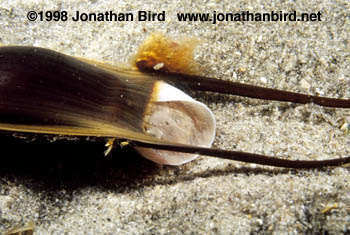By Jessica Jang, Pacific Shark Research Center
Have you ever come across a strange peculiar object that looks like a dried out husk along the beach? Believe it or not, they're not driftwood or anything plant related, but are egg cases!

These egg cases are also commonly known as mermaid purses and vary in shape, sizes, and texture. Species of sharks, skates, and chimeras are know to lay mermaid purses.They are all created internally by the mother, then deposited on the sand floor or wrapped around kelp.
Most of the time, they end up washed up on shore, with nothing in them. Now, you may wonder, what is actually in mermaid's purse? Instead of giving live birth, these oviparous (egg-laying) species of sharks, skates, and chimeras, have found a method of producing offspring limiting the gestation period inside the mother. The eggs are internally fertilized in the female, this is also how the egg case is formed. The egg case is made of keratin, similar to the material from our hair and fingernails, the mother lays the egg case near kelp or on the sand camouflaging the egg case.
Inside there is a tiny embryo waiting to become a shark, skate, or chimera! These embryos are left to fend for themselves as soon as the mother deposits the egg case. Once placed in the perfect environment, the embryo will stay in their egg cases from three to 18 months, even longer, depending on the water temperature. After using up their yolk sacs, these embryos wriggle out and are ready to take on the next step of their lives! Interested in learning how aquariums manage to make a viewing window in an egg case? Click here!



